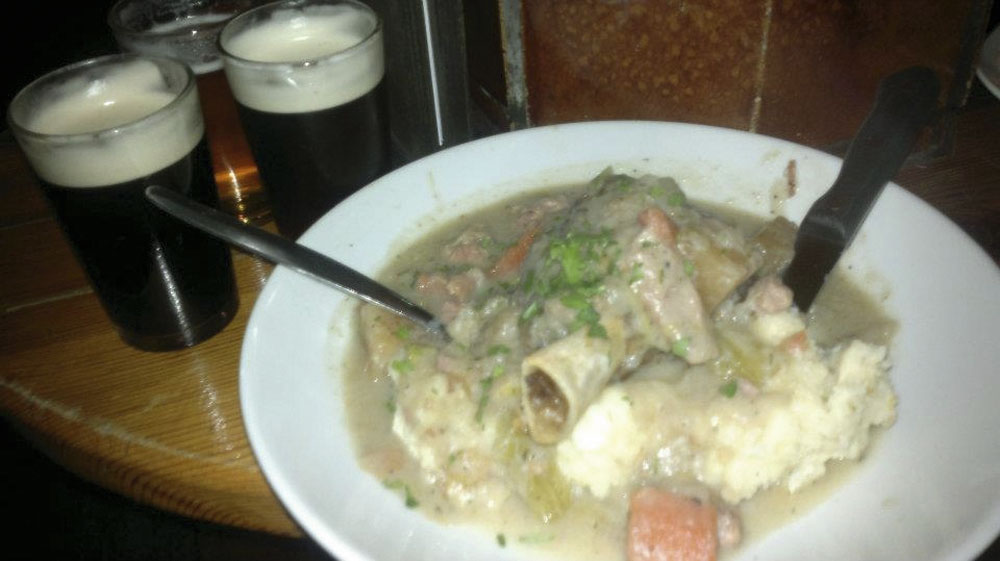”While studying in Ireland, I can report getting slightly tipsy during my first encounter with Irish stew. I wasn’t quite sure if it was because I had the Guinness Stew version or that I simply consumed too much booze that evening, but I liked it: the mix of vegetables, potatoes and tender meat with a hint of barley was just perfect in the cold weather.
But when I happily shared my lovely experience with some of my Irish friends, they either made a funny face or offered some weird comments, like, ‘It’s a cross between a soup and a curry – with potatoes – so I never know whether to eat it with a fork or a spoon,’ said my friend Eileen. ‘When it’s bad, it’s really not good – lumpy, watery, grisly, in the worst case,’ added Debbie.
Irish stew has suffered from less than glamorous reputation in recent years, being associated with pub grub and routine home meals. As my friends put it, it is a ‘comfort food’ that reminds Irish people of ‘childhood’, ‘growing up’, ‘mom’, and ‘grandmas’. For Debbie, a real six o’clock winter meal at the wooden table with stew that warmed her from the inside was a wonderful memory.
‘Stew is the meal that reminds a lot of Irish people of their days growing up, coming home from school on a damp winter’s day,’ recalls PJ.
And when you look past the unsophisticated dish, you will find it rich with lots of nutritious ingredients and herbs: parsley, thyme, onions, large chunks of root vegetables such as carrots and parsnips, and also the secret ingredient: barley. Dubliners have their special version which they call it ‘Coddle’, with preserved salted bacon and sausages as the signature ingredients, served with crispy bread rolls smeared with thick chilled butter to dip into the soup. A more traditional dish called ‘Colcannon’, with curry kale, butter and black pepper, is sometimes served during Halloween.
‘Remember, Pat, you should cook it slowly on a low heat, two hours plus, and use the juices from the meat and vegetables to make a rich sauce. Serve with boiled or mashed potato,’ advises PJ, as I frantically take down notes, while thinking that next time I ought to create my own version of stew and spice it up with a stronger booze, Jameson Irish Whiskey.”
For those who’d like to make your own Irish Stew, follow the simple step-by-step instructions. Be creative (and careful) with the booze!
Prepare:
-
1.5Kg lamb shoulder with a little fat, cubed -
1/2 cup flour -
3 large potatoes, peeled and cubed -
3 large carrots, peeled and sliced -
2 large onions, cut into large dice -
3 – 4 cloves garlic, minced -
herbs: fresh rosemary, parsley and thyme -
3 cups of lamb or beef stock (according to personal preference) -
350g Guinness stout -
1 cup of barley (makes a more authentic Irish country stew) -
2 teaspoons of corn starch -
salt and black pepper
Prepare the herbs (rosemary, parsley and thyme) and reserve them for later. Season the meat with salt and heat the meat in a little oil, sprinkled with a little flour. Use barley, cook it for 20 minutes in 3 cups of lamb or beef stock. Add onions, garlic, carrots to the pan, and also Guinness.
Put the potatoes into the pot with meat and barley, cook with medium heat until boiling, and then reduce to low heat. Simmer for 2 – 3 hours and make sure the meat is very tender, stirring occasionally with cornstarch (mixed with water) and add salt and pepper to taste. The dish is best served with Irish brown or white soda bread, and more Guinness!
“PFIIIIEEEEEJJTT” Ik word eindelijk een beetje wakker en op het laatste nippertje ontwijk ik een grote zilvergrijze auto. Voor het eerst valt me de verkeersmeneer bij de brug onderweg naar de TU-wijk me op. Waarschijnlijk omdat hij wilde gebaren naar me maakt en me nafluit met zo’n officieel verkeersregelaarsfluitje. Hij staat er dus helemaal niet voor niets. Ik heb mezelf net op tijd kunnen redden van vele plastisch-chirurgische ingrepen om het bandenprofiel van mijn lichaam te laten verwijderen.
Sinds ik een fiets heb in Delft sjees ik, zonder te letten op verkeersaanwijzingen, mijn standaardroute van het station naar de library in half slapende toestand. Mijn ochtendroutine bestaat uit de deur uit rennen en op de fiets springen.
Ik had kunnen weten dat dit geen goed idee is. Er zijn talloze mensen die roepen dat routine dodelijk is. Ze hebben het dan wel vooral over de afbreuk aan creativiteit en plezier, maar toch. Uit onderzoek blijkt dat routine in noodsituaties niet als iets positiefs wordt gezien. Mensen lopen rustig de nooduitgangen voorbij en sluiten netjes aan in de rij naar de hoofduitgang waardoor ze dagelijks naar buiten gaan. Met alle gevolgen van dien.
Toch blijven mijn medetrainees en ik naar prettige werkroutines zoeken. De mens is nu eenmaal een gewoontedier. Tegelijkertijd word je als trainee, terecht, gewaarschuwd voor routine. Er wordt van je verwacht dat je een frisse blik blijft werpen op de organisatie. Ook wordt gezegd dat je deuren open mag trappen en kritisch moet zijn. Het voelt echter stiekem wel erg prettig om je meteen aan de standaard aan te passen, een routine te ontwikkelen en lekker mee te gaan met de groep.
Gelukkig gaat de TU Delft me een handje helpen in de strijd tegen routine. Er wordt geëxperimenteerd met het nieuwe werken. Voor zover ik het begrijp, wordt routine dus officieel bemoeilijkt. Nu nog een brandoefening en we zien hopelijk meteen resultaat.



Comments are closed.